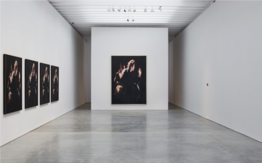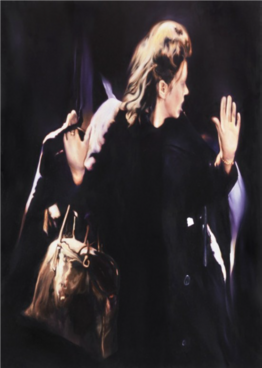Ende dieses Seitenbereichs.
Zur Übersicht der Seitenbereiche.
Beginn des Seitenbereichs: Zusatzinformationen:
Ende dieses Seitenbereichs.
Zur Übersicht der Seitenbereiche.
Gilboa
Beginn des Seitenbereichs: Inhalt:
The Nazi Photograph of Warsaw Ghetto’s Liquidation is Revisited by an Israeli Artist
by Anat Gilboa, Ph.D.
The topic of my research is a series of ten paintings, labelled Mother by Nir Hod, an Israeli-born Jewish artist, who is based in New York City. The paintings were exhibited in Paul Kasmin Gallery in Manhattan in 2012 (figure 1). The project is derived from the well-known 1943 photograph, so-called ‘Boy from the Ghetto Warsaw,’ ‘The Jewish Quarter of Warsaw is no more,’ as well as the ‘Warsaw Ghetto Uprising.’1
In the historical photograph a group of Jewish inmates has been caught by Nazi soldiers, and are forced to leave their hiding places. Their arms are raised while forced to march towards their death. At the center of the group stands a little boy, whose raised arms and frightened expression are in stark contrast to the armed men with their pointed guns. The original snapshot was probably taken by the Nazi Officer Franz Konrad as a visual evidence for the ‘Stroop Report.’ Jürgen Stroop, who assembled the report to confirm the extermination of the Warsaw Ghetto, gave it as a present to the chief SS officer, Heinrich Himmler.
Derived from the 1943 record, Nir Hod chose to paint one female inmate, seen on the left-hand side of the original photograph. Shown in close-up and painted in minute details against a dark background, the same female figure is depicted ten times, walking with raised arms and open lips, disclosing her unexpected rush of surprise (figure 2). At the exhibition, nine similar-scale paintings of the figure were displayed, parallel to one another, on one wall. On an adjacent partition, one painting was positioned, larger than the others. On an opposite side to the nine paintings, a copy of the small photograph of the liquidation of the Ghetto was shown.
By isolating the woman from the original group, Hod shifted the attention to, by then, an overlooked side-figure. Adding various colours and a bright soft aura to, otherwise a small, longstanding monochrome snapshot, Hod transformed a non-distinct female captive into a modern woman, walking in determination towards a target, unknown to the viewer. I would argue, however, that the artist chose to name the series ‘Mother,’ relating aspects of modernity such as individuality and gender equality with traditional Jewish values and ethos.
Nir Hod’s series of paintings is an example of a growing tendency in Israeli artistic discourse, examining the past to better understand it, rather than as a means to perpetuate it, with the hope that universality, transnationality and equality will coexist with longestablished Jewish ethics as a new norm.
1 Franz Konrad (attributed), The Jewish Quarter of Warsaw is no more, photograph, 14 cm. x 9.6
cm., Collection Yad Vashem Museum, Israel.


Ende dieses Seitenbereichs.
Zur Übersicht der Seitenbereiche.
Beginn des Seitenbereichs:
Kontakt
David-Herzog-Fonds der steirischen Universitäten
Beethovenstraße 21
A-8010 Graz
Tel: 0316 380 8073
dhf.stmk(at)uni-graz.at
https://david-herzog-fonds.at/de/
Fördergeber


Ende dieses Seitenbereichs.
Zur Übersicht der Seitenbereiche.


